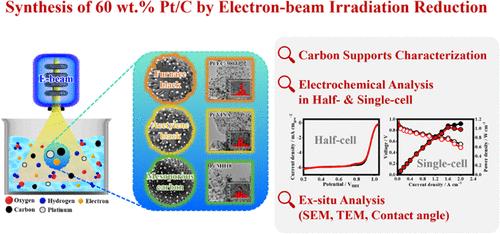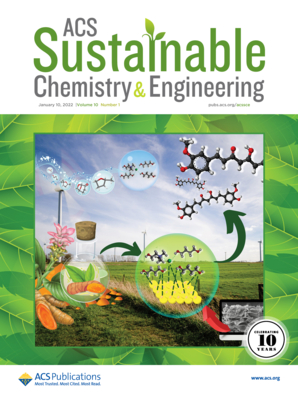Comparative Analysis of Durability and Performance of High-Loaded Pt Catalysts on Various Carbon Supports Using Electron Beam Reduction for Fuel Cells
IF 7.3
1区 化学
Q1 CHEMISTRY, MULTIDISCIPLINARY
引用次数: 0
Abstract
Carbon supports are important for the improved utilization of Pt nanoparticles (NPs), pore formation, and increased electrical conductivity in polymer electrolyte membrane fuel cells. This study uses electron-beam irradiation–reduction, which is a reductant-free catalyst-synthesis method with a fast synthesis time that is easy to scale up for mass production, to synthesize highly loaded and well-dispersed catalysts with 60 wt % of Pt NPs. The supports are prepared as commercial furnace black (EC-300J), acetylene black (Vinatech carbon black; VINA), and mesoporous carbon (MH18). In a half-cell, Pt/VINA displayed outstanding overall electrochemical performance; in particular, its electrochemical surface area (ECSA) has an average value of ∼24.6% higher than that of either of the other two catalysts. In catalyst-durability tests, the change in half-potential at 0.9 VRHE is lower for Pt/VINA (−17.5%) than for either Pt/EC-300J (−25.2%) or Pt/MH18 (−33.9%). Similar results are obtained in single-cell catalyst-durability tests. The durability of the carbon support, evaluated in a single-cell test, shows that Pt/EC-300J exhibits the largest reduction in ECSA (−40.1%), followed by Pt/VINA (−28.9%) and Pt/MH18 (−26.2%). The electrode thickness of the highly crystalline Pt/VINA decreases by only −52.4%, while those of the Pt/EC-300J and Pt/MH18 electrodes are reduced by −66.1 and −60.9%, respectively. Interestingly, Pt/MH18 initially performed poorly due to the bulky carbon supports with narrow pore sizes, which resulted in agglomeration of the catalyst. After the support-durability test, however, the structure of this electrode remained well-maintained and exhibited excellent performance.

电子束还原燃料电池高负载Pt催化剂在不同碳载体上的耐久性和性能对比分析
在聚合物电解质膜燃料电池中,碳载体对于提高Pt纳米颗粒(NPs)的利用率、孔隙形成和提高电导率非常重要。电子束辐照还原是一种无还原剂的催化剂合成方法,具有合成时间快,易于规模化生产的特点。本研究利用电子束辐照还原技术合成了负载高、分散良好的催化剂,Pt NPs含量为60%。支架的配制有:工业炉黑(EC-300J)、乙炔黑(Vinatech炭黑;VINA)和介孔碳(MH18)。在半电池中,Pt/VINA表现出优异的整体电化学性能;特别是,其电化学表面积(ECSA)比其他两种催化剂平均高~ 24.6%。在催化剂耐久性测试中,Pt/VINA在0.9 VRHE下的半电位变化(- 17.5%)低于Pt/EC-300J(- 25.2%)或Pt/MH18(- 33.9%)。在单细胞催化剂耐久性试验中也得到了类似的结果。在单细胞测试中,碳支架的耐久性评估表明,Pt/EC-300J的ECSA降低幅度最大(- 40.1%),其次是Pt/VINA(- 28.9%)和Pt/MH18(- 26.2%)。高结晶Pt/VINA电极厚度仅下降了52.4%,而Pt/EC-300J和Pt/MH18电极厚度分别下降了66.1%和60.9%。有趣的是,Pt/MH18最初表现不佳,这是由于体积庞大的碳载体和狭窄的孔径,导致催化剂团聚。然而,经过支撑耐久性测试,该电极的结构保持良好,并表现出优异的性能。
本文章由计算机程序翻译,如有差异,请以英文原文为准。
求助全文
约1分钟内获得全文
求助全文
来源期刊

ACS Sustainable Chemistry & Engineering
CHEMISTRY, MULTIDISCIPLINARY-ENGINEERING, CHEMICAL
CiteScore
13.80
自引率
4.80%
发文量
1470
审稿时长
1.7 months
期刊介绍:
ACS Sustainable Chemistry & Engineering is a prestigious weekly peer-reviewed scientific journal published by the American Chemical Society. Dedicated to advancing the principles of green chemistry and green engineering, it covers a wide array of research topics including green chemistry, green engineering, biomass, alternative energy, and life cycle assessment.
The journal welcomes submissions in various formats, including Letters, Articles, Features, and Perspectives (Reviews), that address the challenges of sustainability in the chemical enterprise and contribute to the advancement of sustainable practices. Join us in shaping the future of sustainable chemistry and engineering.
 求助内容:
求助内容: 应助结果提醒方式:
应助结果提醒方式:


